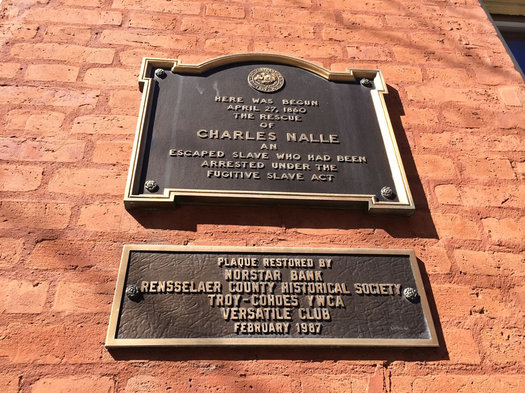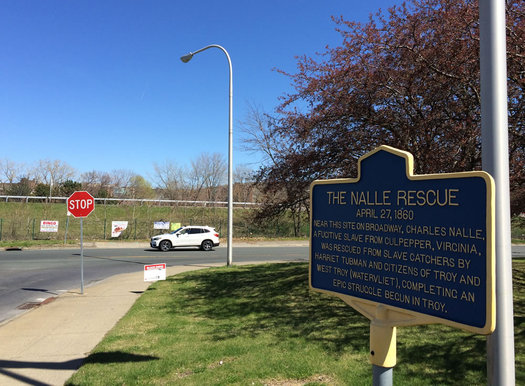The time Harriet Tubman helped lead the rescue of a man in Troy

The spot in Troy where the rescue started.
With the news this week that Harriet Tubman will appear on the $20 bill, it seemed like a good time to highlight the story of how Tubman helped lead the rescue of a man in Troy.
It's an amazing story, full of bravery and tenacity.

image: H. Seymour Squyer, circa 1885 -- from the National Portrait Gallery via Wikipedia
Here's the scene: It's April 1860 and Harriet Tubman -- almost 40 years of age and living in Auburn, New York at the time -- was traveling to Boston to attend an anti-slavery gathering. She stopped in Troy to visit a relative.
While she was in the city, a man named Charles Nalle, who had escaped slavery in Virginia and made a new life for himself in Troy, had been snared in a plot to return him to slavery. A local attorney named Horace Averill -- who had led Nalle to believe he was assisting in an effort to contact Nalle's family -- had instead betrayed Nalle. Averill had arranged for Nalle's return to his owner in Virginia under the Fugitive Slave Act so he could cash in. (By the way, Nalle's owner in Virginia was his half brother. It was said that he and his brother, who was a few years younger, looked very similar and were hard to tell apart.)
So, Nalle's been taken into custody by authorities and is being held in the office of a federal official in downtown Troy at the corner of State and First. Word has gotten around Troy about what's happening and a large crowd of people -- both black and white -- has gathered outside the office.
This clip is from two authorized biographies of Harriet Tubman -- Scenes in the Life of Harriet Tubman and Harriet, the Moses of her People -- both written in the latter part of the 18th century by Sarah Hopkins Bradford. (We've broken up the paragraphs a bit to make it easier to read.):
The instant Harriet heard the news, she started for the office of the U, 8, Com- missioner, scattering the tidings as die went. An excited crowd were gathered about the office, through which Harriet forced her way, and rushed up stairs to the door of the room where the fugitive was detained. A wagon was already waiting before the door to carry off the man, but the crowd was even then so great, and in such a state of excitement, that the officers did not dare to bring the man down. On the opposite side of the street stood the colored people, watching the window where they could see Harriet's sun-bonnet, and feeling assured thai so long as she stood there, the fugitive was still in the office. Time passed on, and he did not appear.

"They've taken him out another way, depend upon that," said some of the colored people. "No," replied others, "there stands 'Moses' yet, and as long as she is there, he is safe."
Harriet, now seeing the necessity for a tremendous effort for his rescue, sent out some little boys to cry fire. The bells rang, the crowd increased, till the whole street was a dense mass of people. Again and again the officers came out to try and clear the stairs, and make a way to take their captive down; others were driven down, but Harriet stood her ground, her head bent down, and her arms folded.
"Come, old woman, you must get out of this," said one of the officers; "I must have the way cleared; if you can't get down alone, some one will help you."
Harriet, still putting on a greater appearance of decrepitude, twitched away from him, and kept her place. Offers were made to buy Charles from his master, who at first agreed to take twelve hundred dollars for him; but when that was subscribed, he immediately raised the price to fifteen hundred. The crowd grew more excited. A gentleman raised a window and called out, "Two hundred dollars for his rescue, but not one cent to his master!" This was responded to by a roar of satisfaction from the crowd below. At length the officers appeared, and announced to the crowd that if they would open a lane to the wagon, they would promise to bring the man down the front way.
The lane was opened, and the man was brought out -- a tall, handsome, intelligent white man, with his wrists manacled together, walking between the U.S. Marshal and another officer, and behind him his brother and his master, so like him that one could hardly be told from the other. The moment they appeared, Harriet roused from her stooping posture, threw up a window, and cried to her friends: "Here he comes -- take him!" and then darted down the stairs like a wild-cat.
She seized one officer and pulled him down, another, tore liim away from the man; and keeping her arms about the slave, she cried to her friends: "Drag us out! Drag him to the river! Drown him ! but don't let them have him!"
They were knocked down together, and while down she tore off her sun-bonnet and tied it on the head of the fugitive. When he rose, only his head could seen, and amid the surging mass of people the slave was no longer recognized, while the master appeared like the slave. Again and again they were knocked down, the poor slave utterly helpless, with his manacled wrists streaming with blood.
Harriet's outer clothes were torn from her, and even her stout shoes were all pulled from her feet, yet she never relinquished her hold of the man, till she had dragged him to the river, where he was tumbled into a boat, Harriet following in a ferryboat to the other side.

But the telegraph was ahead of them, and as soon as they landed he was seized and hurried from her sight. After a time, some school children came hurrying along, and to her anxious inquiries they answered, "He is up in that house, in the third story." Harriet rushed up to the place. Some men were attempting to make their way up the stairs. The officers were firing down, and two men were lying on the stairs, who had been shot. Over their bodies our heroine rushed, and with the help of others burst open the door of the room, dragged out the fugitive, whom Harriet carried down stairs in her arms.
A gentleman who was riding by with a fine horse, stopped to ask what the disturbance meant; and on hearing the story, his sympathies seemed to be thoroughly aroused; he sprang from his wagon, calling out, "That is a blood-horse, drive him till he drops." The poor man was hurried in; some of his friends jumped in after him, and drove at the most rapid rate to Schenectady.
Bradford writes in the autobiographies that this is the version Tubman told her, but "by some persons it seemed to wonderful for belief." The books also include two other accounts, one published in the Troy Whig and another from the attorney Martin Townsend, who had represented Charles Nalle. They all differ a bit from each other, but the story is generally the same across all three.
If you'd like to read more about this episode, you should head over to Brownstoner and read Suzanne Spellen's excellent three part series -- one, two, three -- about it. She provides backstory for many of the people involved, along with historical context.
Nalle's freedom was eventually bought from from his half-brother -- he was later reunited with his wife and children and they lived in Troy for a time.
The next year Tubman would start working the Union army, serving as a military scout and aiding liberated slaves. After the Civil War, she'd go on to be a prominent part of the movement for women's suffrage.
Earlier on AOA: Garnet Douglass Baltimore, who was "as much of Troy as the monument"
Say Something!
We'd really like you to take part in the conversation here at All Over Albany. But we do have a few rules here. Don't worry, they're easy. The first: be kind. The second: treat everyone else with the same respect you'd like to see in return. Cool? Great, post away. Comments are moderated so it might take a little while for your comment to show up. Thanks for being patient.
Comments
It is a great story, though Troy's history (like probably most places) remains a complicated one. Just a few years after the honorable rescue of Charles Nalle an attempt to integrate Troy's high school failed. I think the high school wasn't integrated until 1869 and the lower schools not until a few years later than that. People involved included William Rich (1795-1881) http://www.findagrave.com/cgi-bin/fg.cgi?page=gr&GRid=142207833
... said Christopher K. Philippo on Apr 26, 2016 at 3:42 PM | link